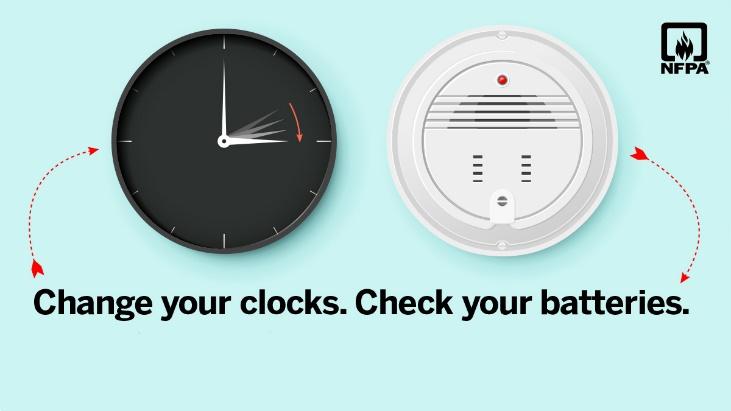Smoke & Carbon Monoxide Alarms
Smoke detectors won’t work if the batteries are dead.
Change all the batteries in your smoke and carbon monoxide alarms at the same time you change your clocks for Standard Time in the fall and Daylight Savings Time in the spring.
Additionally, if your smoke alarms are over 10 years old, they should be replaced. This includes battery operated as well as combination AC/battery powered smoke alarms.

Simple home fire safety tips:
- Practice smoke alarm maintenance for a simple, effective way to reduce home fire deaths.
- When you change your clocks, change the batteries in your smoke alarms and carbon monoxide detectors.
- Test your smoke alarms and carbon monoxide detectors monthly to make sure they are working.
- Have at least one working smoke alarm on each level of your home.
- Plan, discuss and practice an escape route with your family for dangerous situations such as home fires, carbon monoxide leaks and natural disasters.
- Do not rely on your sense of smell to alert you that you and/or your family are in danger of being trapped during a fire or from a carbon monoxide leak.
- Be sure not to ignore the chirping sound your smoke alarm makes when maintenance is required.
- Use flashlights or flameless candles rather than candles to light your home during power outages.
- Carbon monoxide detectors are NOT substitutes for smoke alarms.
What is your alarm telling you?
SMOKE ALARMS
- A continued set of three loud beeps – beep, beep, beep – means smoke or fire. Get out, call 9-1-1, and stay out.
- A single “chirp” every 30 or 60 seconds means the battery is low and must be changed.
- All smoke alarms must be replaced after 10 years.
- Chirping that continues after the battery has been replaced means the alarms is at the end of its life and the unit must be replaced.
CARBON MONOXIDE (CO) ALARMS
- A continuous set of four loud beeps – beep, beep, beep, beep – means carbon monoxide is present in your home. Go outside, call 9-1-1- and stay out.
- A single chirp every 30 or 60 seconds means the battery is low and must be replaced.
- CO alarms also have “end of life” sounds that vary by manufacturer. This means it’s time to get a new CO alarm.
Chirping that continues after the battery has been replaced means the alarm is at the end of its life and the unit must be replaced.
Make sure your smoke and CO alarms meet the needs of everyone in your home, including those with sensory or physical disabilities.
Some tips:
What’s the difference between smoke alarms and carbon monoxide (CO) alarms? Why do I need both?
Smoke alarms sense smoke well before you can, alerting you to danger. In the event of fire, you may have as little as 2 minutes to escape safely, which is why smoke alarms need to be in every bedroom, outside of the sleeping areas (like a hallway), and on each level (including the basement). Do not put smoke alarms in your kitchen or bathrooms.
Carbon monoxide is an odorless, colorless gas that displaces oxygen in your body and brain and can render you unconscious before you even realize something is happening to you. Without vital oxygen, you are at risk of death from carbon monoxide poisoning in a short time. CO alarms detect the presence of carbon monoxide and alert you so you can get out, call 9-1-1, and let the professionals check your home.
How do I know which smoke and CO alarm to choose for my home?
Choose an alarm that is listed with a testing laboratory, meaning it has met certain standards for protection. Whether you select a unit that requires yearly changing of batteries, or a 10-year unit that you change out at the end of the 10 years, either will provide protection.
CO alarms also have a battery backup. Choose one that is listed with a testing laboratory. For the best protection, use combination smoke and carbon monoxide alarms that are interconnected throughout the home. These can be installed by a qualified electrician, so that when one sounds, they all sound. This ensures you can hear the alarm no matter where in your home the alarm originates.

